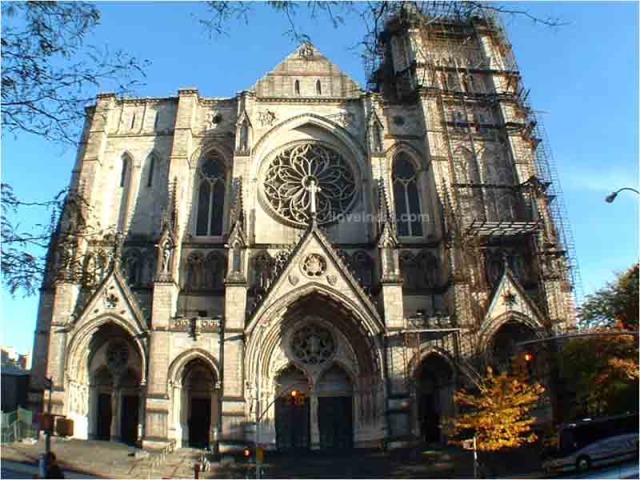St. John-the Unfinished is not just World’s fourth largest Christian church, but also a symbol of New York’s religious sentiments. Check out some fun facts about Cathedral Of St. John The Divine.
Facts Of Cathedral Of St. John The Divine
Located at 1047 Amsterdam Avenue, New York, in Manhattan's Morningside Heights is the Cathedral Church of Saint John the Divine in the City and Diocese of New York. The church also known as “The Cathedral of St. John the Divine” is the Cathedral of the Episcopal Diocese of New York. This church gives an old-world feeling complete with medieval architecture against the backdrop of one of the most modern cities in the world. The church is relatively young and is one the few churches in United States, which exhibit Gothic and Romanesque architecture. Unites States, being a nation fairly younger to other Christian countries, has very few churches that date back to the medieval times and this church though recent in construction, still exhibits a lot of the old-world charm. Let us look at some of the most interesting features of this marvel.

Interesting & Fun facts About The Cathedral of St. John the Divine
-
Although the concept of the Cathedral Church of St. John the Divine was first formulated around 1828, it obtained official recognition only when Rt. Rev. Horatio Potter, Bishop of New York, proposed the idea at the Diocesan Convention of 1872, after a gap of nearly 44 years.
-
Even though the proposal received unanimous support, it took another 20 years for the work to begin in 1892.
-
However, the problems were far from over, when even two years of digging, the workers failed to reach bedrock. With the help of a donation from J.P Morgan in the amount of $500,000, the builders were finally able to hit bedrock seventy two feet below the surface level.
-
The original design by the New York firm, of George Lewis Heins and C. Grant LaFarge in a Byzantine-Romanesque style was scrapped in 1891 and replaced by a new Gothic plan by the noted Gothic Revival architect Ralph Adams Cram of the Boston firm Cram, Goodhue and Ferguson.
-
The cathedral was opened end-to-end for the first time only on November 30, 1941, a week before the bombing of Pearl Harbor.
-
Cram intended to dismantle the large central dome made of Guastavino tile and construct a massive Gothic tower in its place. This plan was ultimately never realized. The dome was completed in 1909 before Cram took over.
-
The cathedral is 186 m in length, and the nave ceiling reaches 37.7 m high. The naive is the tallest in the United States with a height of 70 m.
-
Seven chapels radiating from the ambulatory behind the choir are each designed in a distinctive nationalistic style, representing each of the seven most prominent ethnic groups to first immigrate to New York City, upon the opening of Ellis Island in 1892, the same year the Cathedral was begun.
-
These chapels, known as the "Chapels of the Tongues", are devoted to St. Ansgar, who is venerated as an apostle to the Scandinavian countries; St. Boniface, apostle of the Germans; St. Columba, patron of Ireland and Scotland; St. Savior (Holy Savior), devoted to immigrants from the east, St. Martin of Tours, patron of the French; St. Ambrose, patron of Italy; and St. James, patron of Spain.
-
The cathedral's bronze doors were cast by Barbedienne, the same man who cast the Statue of Liberty.
-
The cathedral's Great Rose Window is 40 feet in diameter and is composed by over 10,000 pieces of glass.
-
The Cathedral contains a "Poet's Corner" paying tribute to great authors in American History much like the Westminster abbey in England does for English poets.
-
The Cathedral's eight granite columns behind the altar are 6 feet in diameter, 55 feet high, and weigh 130 tons each.
-
The Cathedral's grounds contain a Biblical Garden, in which the herbs and flowers appearing in the Bible are grown.
-
In 2001, a fire almost destroyed the church. But again the restoration work began in 2005 and finished in 2008
-
The cathedral clashes with the Liverpool Anglican Cathedral for the title of largest Cathedral and Anglican Church and fourth largest Christian church in the world.
-
A large fire almost destroyed the entire church on December 18, 2001. It was closed for repairs and restoration began in 2005 with a large scale cleaning process also undertaken.
-
It reopened in November 2008 and still remains unfinished, with construction and restoration being a continuing process. This is the reason for the nickname given to it; St. John the Unfinished.
See also
More from iloveindia.com
- Home Remedies | Ayurveda | Vastu | Yoga | Feng Shui | Tattoos | Fitness | Garden | Nutrition | Parenting | Bikes | Cars | Baby Care | Indian Weddings | Festivals | Party ideas | Horoscope 2015 | Pets | Finance | Figures of Speech | Hotels in India : Delhi | Hyderabad | Chennai | Mumbai | Kolkata | Bangalore | Ahmedabad | Jaipur
- Contact Us Careers Disclaimer Privacy Policy Advertise With Us Lifestyle Sitemap Copyright iloveindia.com. All Rights Reserved.







